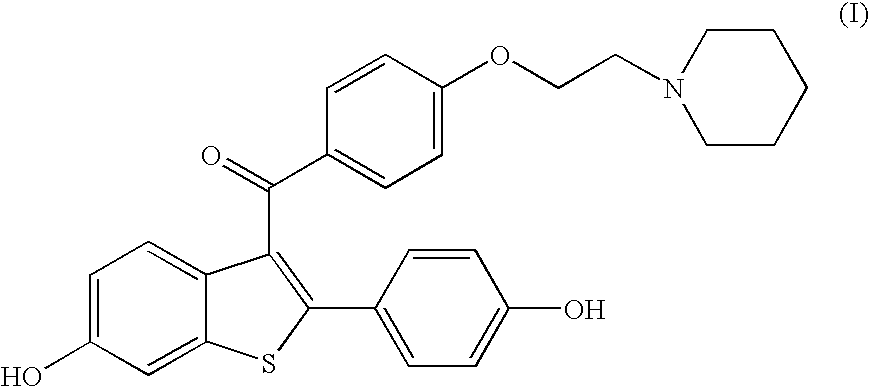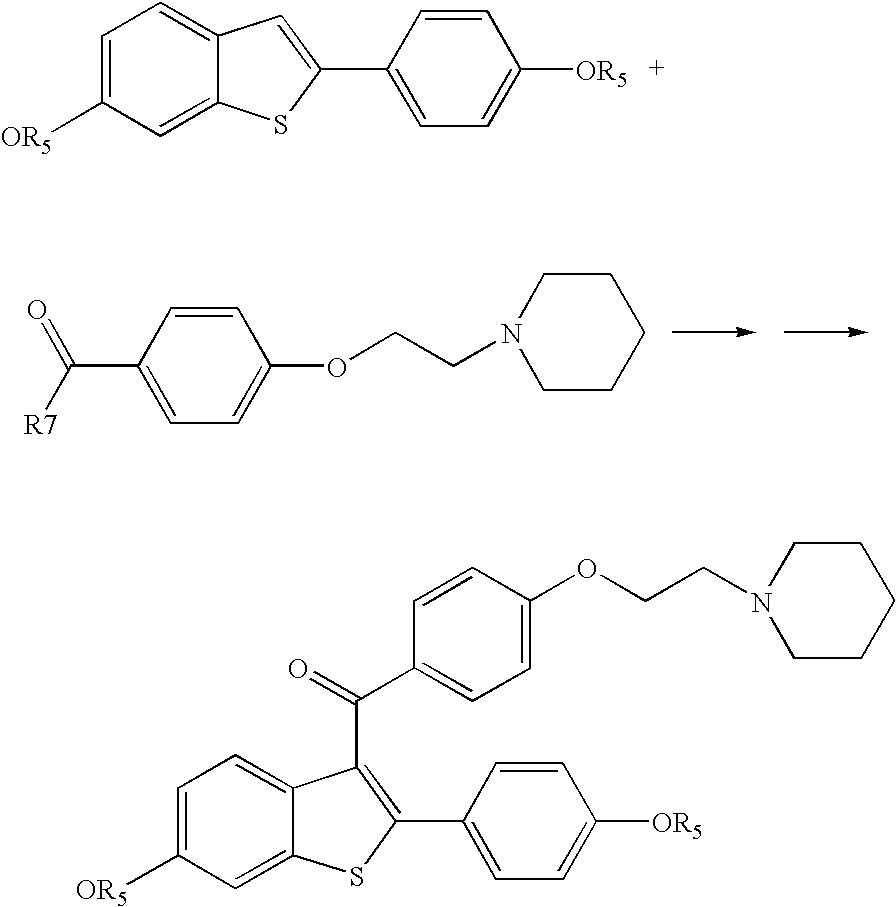Process for preparing raloxifene hydrochloride
a technology of raloxifene and hydrochloride, which is applied in the field of preparing raloxifene, can solve the problems that the hydrolysis process does not allow the extraction of high-purity raloxifene, and achieve the effect of high purity and high yield
- Summary
- Abstract
- Description
- Claims
- Application Information
AI Technical Summary
Benefits of technology
Problems solved by technology
Method used
Image
Examples
example 1
Preparation of 6-acetoxy-2-(4-acetoxyphenyl)benzo[b]thiophene (IV)
[0026] 24 kg of pyridine (0.303 kmol) and 28.8 kg of 37% hydrochloric acid (0.292 kmol) are fed into a reactor. The reactor is placed under vacuum and all the water is distilled off until a thick but stirrable residue is obtained.
[0027] The residue is then redissolved in 6 kg of tributylamine and 6 kg of 6-methoxy-2-(4-methoxyphenyl)benzo[b]thiophene (0.022 kmol). The mixture is heated to 170-180° C. and is maintained at this temperature for some hours. It is then cooled to 50-60° C. and 24 kg of ethyl acetate and 60 kg of deionised water are fed into the reactor. The mixture is stirred for 15 minutes and the phases are separated. The solvent is distilled off from the organic phase under vacuum and the residue is redissolved with 24 kg of ethyl acetate and 5.3 kg of triethylamine (0.052 kmol). The mixture obtained is heated to 60-65° C. while being stirred and 8.9 kg of acetic anhydride (0.087 kmol) are added. The r...
example 2
Preparation of Crude Raloxifene Hydrochloride.
PHASE A
[0029] 42 kg of methylene chloride and 7.8 kg of 4-(2-piperidinoethoxy)-benzoic acid hydrochloride (0.027 kmol), 0.12 kg pyridine (0.0015 kmol) are fed into a reactor and heated under reflux and then 3.96 kg of thionyl chloride (0.033 kmol) are added. The mixture is stirred for 1 hour then about 20 litres of methylene chloride are distilled off. The mixture is cooled to 20-30° C. and 6 kg of 6-acetoxy-2-(4-acetoxyphenyl)benzo[b]thiophene (IV) (0.018 kmol) are added.
[0030] The mixture is stirred until is completely homogenised.
PHASE B
[0031] 36 kg of methylene chloride and 16.8 kg of aluminium trichloride (0.126 kmol) are fed into a reactor.
[0032] While stirring, the chloromethylene suspension, comprised of phase A prepared as described above, is added at 15-30° C. The mixture is stirred for 1 hour then the entire reaction mixture is poured into a reactor containing 60 kg of ice.
[0033] The mixture is stirred at 15-30° C. t...
example 3
Crystallisation of Crude Raloxifene Hydrochloride (1st Crystallisation of Crude Raloxifene Hydrochloride)
[0036] 6 kg of deionised water, 6 kg of crude raloxifene hydrochloride prepared as described in example 2 and 107 kg of methyl alcohol are fed into a reactor. The reaction mixture is heated until a complete solution is obtained then 0.25 kg of decolourising carbon are added. It is stirred for 15 minutes and then the suspension is filtered. While maintaining the solution stirred, 67 kg of methyl alcohol are distilled off. The residue is cooled and 0.1 kg of 37% hydrochloric acid are added. The pH, which must not exceed 2, is checked and the reaction mixture is then stirred for 2 hours at 20-40° C. The suspension is centrifuged, washing with 6 kg of methyl alcohol. 4.5 kg of dried product are obtained with HPLC purity of >99% and a yield of 75%.
PUM
| Property | Measurement | Unit |
|---|---|---|
| Temperature | aaaaa | aaaaa |
| Temperature | aaaaa | aaaaa |
| Fraction | aaaaa | aaaaa |
Abstract
Description
Claims
Application Information
 Login to View More
Login to View More - R&D
- Intellectual Property
- Life Sciences
- Materials
- Tech Scout
- Unparalleled Data Quality
- Higher Quality Content
- 60% Fewer Hallucinations
Browse by: Latest US Patents, China's latest patents, Technical Efficacy Thesaurus, Application Domain, Technology Topic, Popular Technical Reports.
© 2025 PatSnap. All rights reserved.Legal|Privacy policy|Modern Slavery Act Transparency Statement|Sitemap|About US| Contact US: help@patsnap.com



